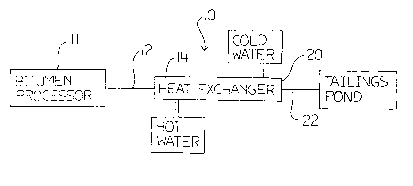Some of the information on this Web page has been provided by external sources. The Government of Canada is not responsible for the accuracy, reliability or currency of the information supplied by external sources. Users wishing to rely upon this information should consult directly with the source of the information. Content provided by external sources is not subject to official languages, privacy and accessibility requirements.
Any discrepancies in the text and image of the Claims and Abstract are due to differing posting times. Text of the Claims and Abstract are posted:
| (12) Patent Application: | (11) CA 2230035 |
|---|---|
| (54) English Title: | OILSANDS TAILINGS HEAT EXCHANGER |
| (54) French Title: | ECHANGEUR DE CHALEUR POUR LES REJETS PROVENANT DU TRAITEMENT DES SABLES BITUMINEUX |
| Status: | Deemed Abandoned and Beyond the Period of Reinstatement - Pending Response to Notice of Disregarded Communication |
| (51) International Patent Classification (IPC): |
|
|---|---|
| (72) Inventors : |
|
| (73) Owners : |
|
| (71) Applicants : |
|
| (74) Agent: | THOMPSON LAMBERT LLP |
| (74) Associate agent: | |
| (45) Issued: | |
| (22) Filed Date: | 1998-02-20 |
| (41) Open to Public Inspection: | 1998-03-20 |
| Examination requested: | 1998-02-20 |
| Availability of licence: | N/A |
| Dedicated to the Public: | N/A |
| (25) Language of filing: | English |
| Patent Cooperation Treaty (PCT): | No |
|---|
| (30) Application Priority Data: | None |
|---|
An energy recovery system for an oilsands plant.
A heat exchanger is connected to a source of hot coarse
tailings from the oilsands plant. The heat exchanger is
provided by an inner pipe, surrounded by an outer pipe,
which together form an annulus, with fins extending from
the outer pipe into the annulus. The inner pipe has an
unobstructed interior bore. The outer pipe is preferably
spaced from the inner pipe by the fins. Cold water is
flowed into the annulus from an inlet to a hot water
outlet, preferably at opposed ends of the heat exchanger,
with flow in the annulus countercurrent to flow in the
inner pipe. The interior surface of the inner pipe is
preferably coated with abrasion resistant material,
preferably chromium carbide. The outer pipe is covered by
insulation.
Système de récupération de l'énergie utilisée dans une installation de traitement des sables bitumineux. Un échangeur de chaleur est formé d'un tuyau intérieur qu'entoure un tuyau extérieur. Ensemble, les deux tuyaux forment un espace annulaire, et des ailettes vont du tuyau extérieur vers l'espace annulaire. L'alésage du tuyau intérieur n'est pas obstrué. Le tuyau extérieur est, de préférence, éloigné du tuyau intérieur par les ailettes. De l'eau froide est introduite dans l'espace annulaire à partir d'une entrée jusqu'à une sortie d'eau chaude, de préférence, aux extrémités opposées de l'échangeur de chaleur, et l'écoulement à contre-courant dans l'espace annulaire passe dans le tuyau intérieur. La surface intérieure du tuyau intérieur est, de préférence, revêtue d'un matériau résistant à l'abrasion, notamment du carbure de chrome. Le tuyau extérieur est recouvert de matériau isolant.
Note: Claims are shown in the official language in which they were submitted.
Note: Descriptions are shown in the official language in which they were submitted.

2024-08-01:As part of the Next Generation Patents (NGP) transition, the Canadian Patents Database (CPD) now contains a more detailed Event History, which replicates the Event Log of our new back-office solution.
Please note that "Inactive:" events refers to events no longer in use in our new back-office solution.
For a clearer understanding of the status of the application/patent presented on this page, the site Disclaimer , as well as the definitions for Patent , Event History , Maintenance Fee and Payment History should be consulted.
| Description | Date |
|---|---|
| Application Not Reinstated by Deadline | 2001-02-20 |
| Time Limit for Reversal Expired | 2001-02-20 |
| Deemed Abandoned - Failure to Respond to Maintenance Fee Notice | 2000-02-22 |
| Inactive: IPC assigned | 1998-08-04 |
| Inactive: First IPC assigned | 1998-07-27 |
| Inactive: IPC assigned | 1998-07-27 |
| Inactive: IPC assigned | 1998-07-27 |
| Inactive: IPC assigned | 1998-07-27 |
| Classification Modified | 1998-07-27 |
| Filing Requirements Determined Compliant | 1998-05-11 |
| Inactive: Filing certificate - RFE (English) | 1998-05-11 |
| Application Received - Regular National | 1998-05-08 |
| Application Published (Open to Public Inspection) | 1998-03-20 |
| Request for Examination Requirements Determined Compliant | 1998-02-20 |
| All Requirements for Examination Determined Compliant | 1998-02-20 |
| Abandonment Date | Reason | Reinstatement Date |
|---|---|---|
| 2000-02-22 |
| Fee Type | Anniversary Year | Due Date | Paid Date |
|---|---|---|---|
| Application fee - small | 1998-02-20 | ||
| Request for examination - small | 1998-02-20 |
Note: Records showing the ownership history in alphabetical order.
| Current Owners on Record |
|---|
| STEPHEN J. LANE |
| Past Owners on Record |
|---|
| None |